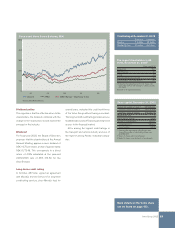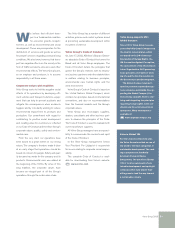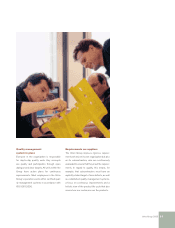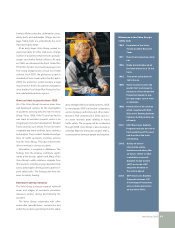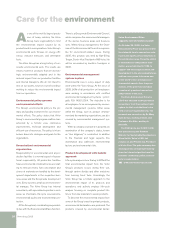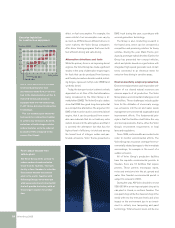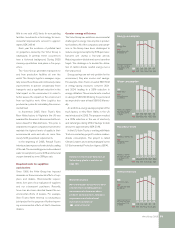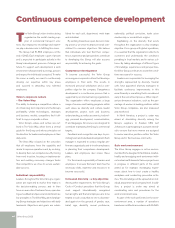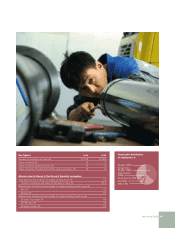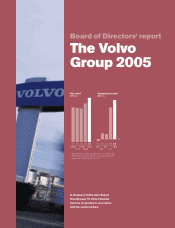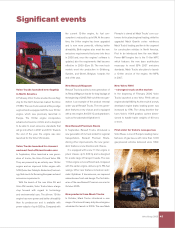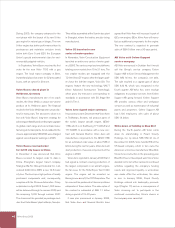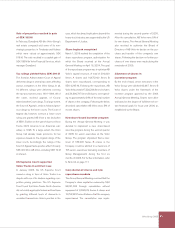Volvo 2005 Annual Report Download - page 43
Download and view the complete annual report
Please find page 43 of the 2005 Volvo annual report below. You can navigate through the pages in the report by either clicking on the pages listed below, or by using the keyword search tool below to find specific information within the annual report.
Volvo Group 2005 39
More information
More information about Volvo’s envir-
onment efforts including pol icies,
environmental information about
products and production, emissions
requirements and educational
materials is available at:
www.volvo.com
fifth to one sixth of EU limits for new painting
facilities. Investments in technology for envir-
onmental improvements amount to approxi-
mately SEK 245 M.
Each year the existence of polluted land
on properties owned by the Volvo Group is
catalogued. In general, these occurrences
have a historical background. During 2005
cleaning-up activities took place in five prop-
erties.
The Volvo Group generates transports to
and from production facilities all over the
world. The Group’s logistics managers regu-
la rly re vie w the se flows and con ti nuous ly make
improvements to achieve considerably fewer
transports and a significant reduction in the
total impact on the environment. In order to
better assess the impact on the environment
from our logistics work, Volvo Logistics has
produced a system for calculating the environ-
mental load.
In September 2005, Volvo Truck’s New
River Valley factory in Virginia in the US was
awarded the Governor’s Environmental Excel-
lence Award for Manufacturers. This prize is
awarded to recognize companies that strive to
maintain the highest levels of quality in their
environmental work and who do more than
merely fulfill prescribed requirements.
In the beginning of 2005, Renault Trucks
int ro duc ed a ne w p roc ess fo r e lec t ro ly ti c c oat in g
of the cab. The new coating process has reduced
water consumption by some 20% and chemical
oxygen demand by some 35% per cab.
Requirements on suppliers
and dealers
Since 1996, the Volvo Group has imposed
demands on the environmental efforts of sup-
pliers and dealers. Environmental require-
ments form part of our evaluation of suppliers
and our subsequent purchases. Recently,
focus has also been directed toward the en-
vironmental efforts of dealers. For example,
Volvo Trucks North America is conducting a
joint project for the purpose of further improv-
ing environmental efforts of North American
dealers.
Greater energy efficiency
The Volvo Group has ambitious environmental
challenges for energy consumption in produc-
tion facilities. All of the companies and operat-
ions in the Group have been challenged to
reduce energy consumption by 50% per manu-
factured unit during a five-year period.
Reducing carbon-dioxide emissions is another
target. The challenge is to double the utiliza-
tion of carbon-dioxide neutral energy over a
five-year period.
Energy savings are not only positive for the
environment, they also involve cost savings.
For example, Volvo Trucks invested SEK 80 M
in energy-saving measures between 2001
and 2004, leading to a 29% reduction in
energy utilization. These investments resulted
in savings of SEK 200 M during the period and
are expected to save at least SEK 50 M annu-
ally.
An ambitious energy savings program at the
truck factory in New River Valley in the US
was introduced in 2003. The program resulted
in a 20% reduction in the use of electricity
and natural gas during 2004. Savings to date
amount to approximately SEK 20 M.
In the US, Volvo Trucks is working with Mack
Trucks in a voluntary project to reduce carbon-
dioxide consumption. The project is called
Climate Leaders and is being managed by the
US Environmental Protection Agency (EPA).
Energy consumption/
net sales has been
reduced by 13%
in 2005.
Energy consumption
Energy, TWh
Energy/net sales
MWh/SEK M
2.6 2.6 2.6
14.3 14. 5 14. 9
2.7
13.4
2.7
11. 6
01 02 03 04 05
Water consumption/
net sales has been
reduced by 24%
in 2005.
Water consumption
Water, Mm3
Water/net sales
m3/SEK M
9.2 9.2 8.6
50.9 52.0 49.1
8.5
42.2
7.4
32.1
01 02 03 04 05
Hazardous waste/
net sales has been
reduced by 17%
in 2005.
Hazardous waste
Hazardous waste, k ton
Waste/net sales
kg/SEK M
20.3 20.5 21.6
112 116 124
24.7
123
23.6
102
01 02 03 04 05
Solvent emissions/
net sales has been
reduced by 17%
in 2005.
Solvent emission
Emissions, k ton
Emission/net sales
kg/SEK M
1.8 1.9 2.0
10.1 10.7 11.2
2.1
10.3
1.9
8.5
01 02 03 04 05
Detailed environmental data from all
Volvo Group plants is available on
page 153.
➡


